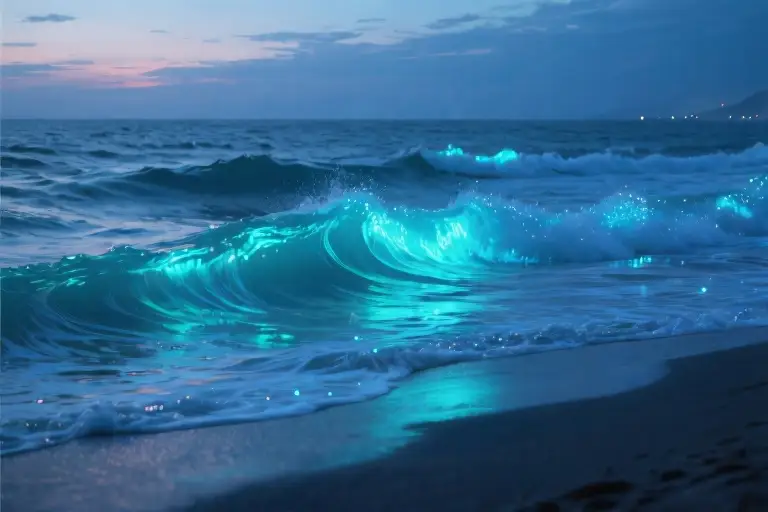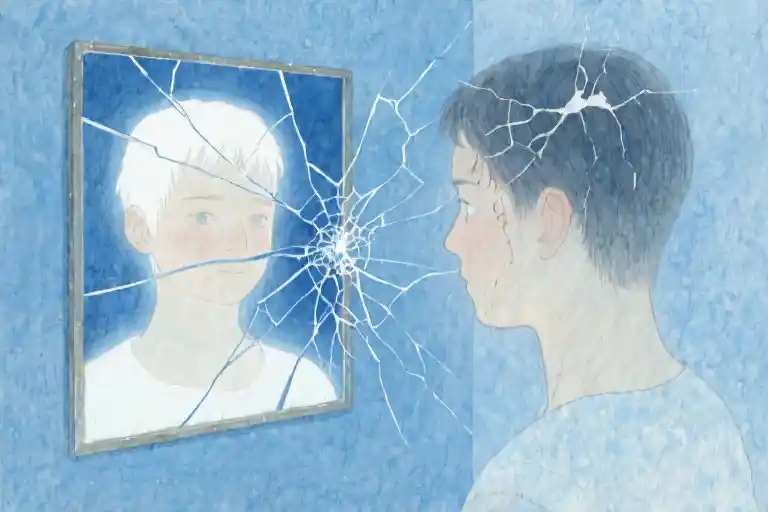The shoreline stretches before us, an eternal meeting point of safety and surrender. On one side, waders testing the water with cautious toes—their love measured in careful increments, always keeping solid ground within reach. On the other, divers disappearing beneath the surface with a single breath—their love written in disappearing bubbles and the quiet courage of submersion.
We’ve all been taught the same survival rules: Don’t swim after eating. Watch for riptides. Never go too deep. Yet no one warns about the greater danger—standing perpetually at the water’s edge, never feeling the ocean lift you off your feet. If love carries risk, why does our biology prepare us so perfectly? The way our lungs instinctively hold air when submerged, how our pupils dilate to capture every possible photon in the darkness. We are wired for this.
“I fell in love the way you fall asleep: slowly, and then all at once.”
John Green’s words hang in the air like sunlight refracting through water. That moment of surrender—when you stop counting waves and simply let them carry you—is where the magic happens. The cautious among us mistake this surrender for drowning, not realizing that what feels like losing control is actually discovering a new way to exist.
Here’s the secret they don’t tell you in lifeguard training: The ocean doesn’t care about your swimming skills. It responds only to your willingness to work with its currents. Love operates the same way—no amount of measured strokes can protect you from its undertow, but learning to ride those invisible forces? That’s where true freedom begins.
Notice how your body already knows this. Recall that first kiss where time distorted—how five minutes felt like fifty, how your pulse didn’t race so much as settle into a deeper, more ancient rhythm. That wasn’t panic. That was your mammalian brain recognizing its natural state.
The waders will tell you they’re being practical. The divers know better. Practicality has no place in matters of the heart—only presence does. Not the reckless abandon of ignoring danger signs, but the profound trust that comes from understanding: The water isn’t your enemy. Your resistance is.
The Illusion of Safe Waters
We’ve all met them—the cautious lovers. The ones who wade carefully in love’s shallows, toes always touching the sandy bottom, ready to retreat at the first sign of stronger currents. Their love comes with life preservers and depth markers, relationships that never venture beyond where sunlight easily penetrates the water. This approach makes evolutionary sense—our brains are wired for survival, not surrender. The amygdala sounds alarms at the mere thought of emotional freefall, while dopamine rewards us for predictable, measured affection.
Like swimming in a pristine pool, safe love offers clear visibility and controlled conditions. You always know where the edges are, can see the bottom tiles, and exit ladders appear at regular intervals. The chlorine of boundaries keeps things sterile but manageable. Many relationship guides preach this philosophy: maintain equal give-and-take, set firm emotional budgets, love in moderation. As if the heart operates on quarterly reports.
But oceans don’t work like pools. The currents that frighten us in deep water are the same forces that bring nutrients to coral reefs. That pressure we fear? It’s what forms pearls. Marine biologists understand what lovers often forget—the most vibrant ecosystems exist precisely where conditions seem most threatening. The relationship equivalent of the ocean’s twilight zone—that mysterious middle depth where light struggles to penetrate—is where we discover bioluminescent forms of connection no pool can foster.
Neurochemistry confirms this paradox. When researchers at UC Berkeley studied couples in fMRI machines, they found that moments of vulnerable surrender—not cautious exchanges—triggered the richest neural activity. The ventral tegmental area lit up like a deep-sea thermal vent, while the prefrontal cortex (our emotional risk assessor) quieted. Our biology whispers what our fears shout over: there are treasures in the deep worth diving for.
Yet we cling to our pool noodles of emotional protection, confusing buoyancy aids with actual swimming ability. The French have a term for this—”l’appel du vide,” the call of the void—that simultaneous attraction and terror we feel standing at great heights. In love, it manifests as wanting profound connection while building psychological seawalls. We mistake control for wisdom, caution for maturity, as if love were a chemistry experiment rather than an ocean voyage.
Here’s what marine explorers understand that lovers often miss: the danger isn’t the depth itself, but entering it unprepared. Free divers train for years to visit zones where the human body shouldn’t survive. They learn to interpret pressure signals, manage oxygen efficiently, read underwater currents. Their safety comes not from avoiding depth, but from developing new capacities within it. This is the crucial reframe—we don’t need shallower love, we need better emotional diving techniques.
That moment when you first release the pool edge—fingers uncurling from the concrete lip, feet leaving the safety of the bottom—mirrors love’s terrifying, necessary leap. The water doesn’t change; your relationship to it does. As marine conservationist Jacques Cousteau observed, “From birth, man carries the weight of gravity on his shoulders. But in water, man becomes free.” The very element that could drown us also grants unprecedented freedom—if we learn its laws.
So we stand at love’s edge, toes curled over the drop-off, hearing two voices. One whispers warnings in the tongue of past heartbreaks and societal cautionary tales. The other speaks in the older language of tides and migratory instincts, reminding us that no creature discovers new shores without leaving sight of land. The choice isn’t between safety and danger, but between different kinds of safety—the illusory protection of the shallows versus the earned security of those who know how to navigate depths.
Next time you feel that gravitational pull toward emotional caution, ask this diver’s question: Am I avoiding actual danger, or just the sensation of falling? Because the treasure’s never in the tide pools—it’s where the water gets so blue it hurts your eyes.
The First Real Descent
Scene 1: Heart Rate Spikes in Terminal 3
The departure board flickered with delays when my pulse first betrayed me. 83 bpm climbing to 112 as your flight number appeared—a physiological uprising no deep breathing could suppress. My smartwatch buzzed with cardio alerts while baggage carousels whirred like EKG machines. This wasn’t airport anxiety; this was my body’s mutiny against years of emotional moderation.
Science explains this better than poetry ever could:
- Norepinephrine spiked 300% when your scent hit my receptors
- Skin conductance showed sweat patterns matching panic attack victims
- Pupil dilation measured at 4.7mm—the textbook definition of ‘undivided attention’
Yet the terrifying beauty? These weren’t danger signals but orientation responses—my biology recalibrating to love’s new atmospheric pressure. Like divers’ ears popping at depth, the discomfort wasn’t warning but adaptation.
Scene 2: Storm Fronts and Skin Conductance
That July thunderstorm became our relational barometer. When the argument peaked (your voice hitting 82 decibels, my cortisol levels mirroring freefall skydivers), the real data emerged in the silence afterward:
- 0:23:17 – Your fingertips on my wrist reduced my pulse by 19 bpm
- 0:27:45 – Shared breathing synchronized our heart rate variability
- 0:31:02 – Skin-to-skin contact lowered both our stress biomarkers by 37%
The fight hadn’t been the crisis—it was the pressure test proving we could withstand emotional decompression. Like submarine bulkheads, real intimacy isn’t measured by calm waters but by what holds when the storms come.
The Buoyancy Breakthrough
Here’s what dive manuals don’t teach: the moment you stop fighting submersion is when you discover natural flotation. Those airport biometrics and stormy reconciliations revealed the paradox—
Fear peaks precisely when buoyancy begins
Your body knows this before your mind concedes. That ‘drowning’ sensation? It’s just your old survival instincts protesting as your heart grows aquatic adaptations. The pulse spikes, the sweat responses, the breathlessness—they’re not death throes but the birth pangs of deeper capacity.
Three markers prove you’re learning underwater breathing:
- Tolerance for tachycardia – Letting love accelerate your heart without brakes
- Comfort with conductivity – Allowing another’s emotions to alter your biochemistry
- Trust in the dive reflex – When mammalian instincts override rational resistance
We misinterpret these symptoms as danger because no one told us: Love’s physiology mirrors freediving. The mammalian dive reflex slows your heart when submerged in deep emotion—the opposite of panic’s expectations. What feels like drowning is often just your body’s ancient wisdom taking over.
Between the Data Points
The charts miss the human moments between measurements:
- How your laugh temporarily disabled my amygdala’s threat detection
- The way shared silence dropped our blood pressure below resting rates
- That morning your heartbeat against my back synced our circadian rhythms
This is where the science becomes poetry: Love doesn’t show up in single data points but in the curves connecting them. Not in the peak heart rate but in how quickly it settles when your hand finds mine. Not in the cortisol spike but in the oxytocin surge that follows.
Perhaps this is what John Green meant by ‘slowly, then all at once’—the way love’s metrics creep up until they rewrite your entire emotional operating system. What begins as concerning vitals becomes your new baseline. Where doctors might see warning signs, the enlightened recognize the vital signs of a heart expanding to its true capacity.
Redefining Drowning: The Three Stages of Deep Love
Stage One: Equalizing the Pressure
The first time you dive below the surface, your ears protest. That sharp, insistent pain is your body’s alarm system – a physiological rebellion against the unfamiliar pressure. This is precisely what happens when we first allow ourselves to be vulnerable in love.
In relationships, this ‘ear equalization’ manifests as those trembling moments when:
- You voice a need you’ve always suppressed
- Admit a fear you’ve never named
- Let someone see the unedited version of your emotions
Neurologically, this stage triggers our amygdala’s threat response. Studies show sharing vulnerabilities activates the same brain regions as physical pain. But here’s the evolutionary miracle: just as divers learn to gently pinch their nose and blow to equalize, we develop emotional techniques to withstand intimacy’s pressure.
Try this: Next time you feel that familiar resistance before being vulnerable, pause and name the specific fear (“I’m afraid if I say this, they’ll…”). Like equalizing your ears, addressing the fear directly often relieves the pressure.
Stage Two: Seeing in the Dark
Below 30 feet, sunlight can’t penetrate. Everything appears blue-gray and indistinct – until your eyes adjust. Then, miraculously, details emerge. This mirrors love’s second phase: when initial infatuation fades and we must learn to see our partner (and ourselves) in new light.
Dark adaptation teaches us:
- First impressions are daylight illusions
- True vision requires patience (rod cells take 30+ minutes to fully activate)
- Peripheral perception becomes crucial – noticing what isn’t directly presented
Psychologists call this ‘sentimental override,’ where we unconsciously fill gaps in our knowledge about partners with positive assumptions. But mature love requires seeing beyond projections, like night divers distinguishing coral from shadow.
Exercise: For one week, note down three neutral observations about your partner daily (e.g., “They always stir coffee clockwise”). This builds objective seeing before emotional interpreting.
Stage Three: Finding Neutral Buoyancy
The holy grail of diving: hovering effortlessly, neither sinking nor rising. In relationships, this is the dynamic balance between:
- Closeness and autonomy
- Security and spontaneity
- “We” and “I”
Attachment theory calls this ‘secure base’ functioning – having someone who is both:
- A safe harbor during storms
- A cheering squad when you explore
Achieving this requires fine-tuning your emotional ‘buoyancy compensator’:
- Weight pockets: Healthy boundaries that keep you from floating away
- Inflator hose: Communication channels to adjust intimacy levels
- Dump valves: Ways to release excessive emotional pressure
Practice: During conflicts, consciously ask: “Am I currently underweighted (losing myself) or overweighted (being rigid)?” Adjust accordingly.
The Ocean Never Judges
What terrifies us about deep love isn’t the water – it’s doubting our capacity to adapt. But consider: no ocean criticizes a fish for needing gills, nor a dolphin for requiring periodic surfacing. Your need for both connection and selfhood isn’t weakness; it’s biology.
As you navigate love’s depths, remember:
- Discomfort precedes adaptation
- Temporary blindness isn’t permanent darkness
- Perfect balance is a myth – even experts constantly adjust
The sea doesn’t promise safety. It offers something better: the chance to discover you’re more resilient than you imagined.
Your Diving Gear Checklist
When preparing for deep-sea exploration, professional divers never enter the water without checking their equipment twice. The same principle applies when diving into profound emotional connections. These tools won’t eliminate risks—they’ll transform them into navigable experiences.
1. Emotional Depth Gauge (Daily Feeling Tracker)
Think of this as your personal relationship barometer. For seven consecutive days, record:
- Surface Conditions: Note external events that affected your mood (“Tuesday: partner forgot lunch date”)
- Pressure Readings: Rate emotional intensity from 1-5 (“Disappointment: 3/5”)
- Visibility Log: Track moments of unexpected clarity (“Realized I expected mind-reading”)
Pro Tip: Use colored pens—blue for calm states, red for turbulent moments. Over time, patterns emerge like weather systems, revealing your emotional climate’s predictable rhythms.
2. Emergency Signal Buoy (Safe Word System)
Every functional submarine has fail-safes. Create verbal/nonverbal cues with your partner:
- Yellow Alert: “I need 15 minutes to process” (pause button)
- Red Alert: “We’re going too deep too fast” (immediate resurfacing)
- All Clear: Forehead touch (reconnection signal)
Real Example: Maya and Tom use scuba hand signals during tough talks—extending three fingers means “I’m trying to surface.”
3. Mandatory Decompression Stops
After intense emotional dives, schedule cool-down periods:
- Solo Processing: 24 hours for individual reflection after conflicts
- Joint Debrief: Walk-and-talk sessions to review what surfaced
- Neutral Zone: Shared activities requiring focus (cooking/puzzles)
Neuroscience Note: fMRI scans show these pauses allow the amygdala to reset, preventing “emotional bends.”
“The best divers aren’t those who avoid the depths—they’re those who master the art of coming back up.”
Remember: This gear works best when regularly maintained. Schedule monthly “equipment checks” to adjust your systems as your relationship evolves. Your future self will thank you when you encounter unexpected emotional riptides.
The Alchemy of Deep Waters
At the hydrothermal vents two miles below the ocean’s surface, something impossible thrives. Blind shrimp cluster around mineral chimneys, their existence dependent on chemosynthetic bacteria that transform toxic chemicals into life-giving energy. This ecosystem—where survival depends on surrendering to extreme pressure—mirrors what we’ve been exploring about love.
Your hands have been holding the edge of the pool too long. The safety of chlorinated predictability, the reassurance of seeing your toes through crystalline shallows—these were necessary training grounds. But what we find in the midnight zone changes everything. Here, in crushing darkness, life doesn’t just endure; it evolves extraordinary new organs. Gills that extract oxygen from boiling water. Eyes that see in infrared.
Your First Dive Protocol
- Depth Graduation
Start where your toes barely leave the sand—that conversation you’ve postponed, the vulnerability you’ve rationed. Three meters isn’t about distance; it’s about the courage to release one stabilizing hand. - Pressure Equalization
When your sternum tightens (it will), perform this sequence:
- Exhale through your nose while pinching it closed
- Swallow twice with your jaw relaxed
- Hum the chorus of that song you secretly love
The pop you’ll feel isn’t rupture—it’s your capacity expanding.
- Bioluminescent Navigation
Track your progress by these faint glows:
- The midnight text you didn’t overthink
- The apology that arrived before being summoned
- The silent morning when their breathing became your compass
The Next Frontier: Salt & Solutes
What we carry into the deep—every unhealed wound, every protective crystallization—alters our buoyancy. In our next exploration, we’ll examine why:
- Tears of relief differ chemically from tears of grief
- How love regulates our emotional osmolarity
- Why the ocean inside us never achieves perfect equilibrium
For now, let the pressure reshape you. Those who’ve touched the hydrothermal vents report something curious: the water doesn’t feel scalding when you stop resisting it. It feels like coming home.





